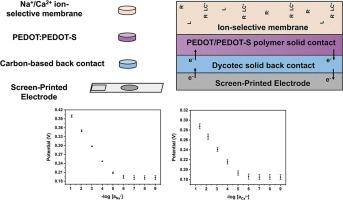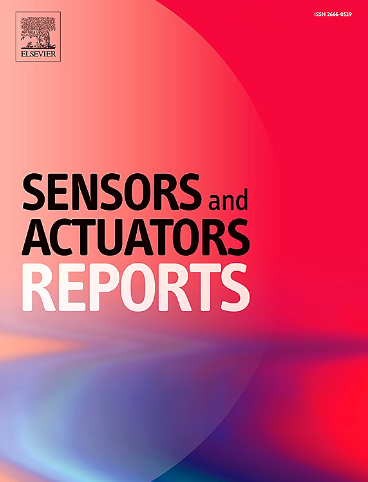免校准可重复使用的丝网印刷离子选择电极的研制
IF 7.6
Q1 BIOTECHNOLOGY & APPLIED MICROBIOLOGY
引用次数: 0
摘要
利用碳糊和PEDOT: PEDOT-S (S=磺化)背接触,开发了可重复使用的无需校准的固态丝网印刷离子选择电极(SP-ISEs)。无需校准的Na+和Ca2+ sp - ise分别表现出接近Nernstian的响应,分别为52.1±2.0 mV/log [aNa+]和27.3±0.8 mV/log [aCa2+],并且在多个批次的多次校准中保持稳定的截取时间为12小时和超过7天。独特的碳糊和PEDOT: PEDOT- s共聚物结合了碳衬底上的背接触,使我们能够通过对单价Na+和二价Ca2+阳离子的不同离子载体进行恒定的低电流处理来固定截距。这种处理赋予了卓越的潜在稳定性,导致多个测量周期中单个ise的校准曲线高度重叠,证明了它们在无校准模式下的可重用性。这些sp - ise对主要干扰离子保持了各自的选择性,并且能够在没有任何固化溶液的情况下长时间干燥储存的情况下重复工作,测试了总共28天。通过对自来水(分别为934±37 μM和194±11 μM)和水培溶液(分别为757±43 μM和7047±565 μM)中Na+和Ca2+浓度的分析,验证了传感器的实用性。这种将高性能特性集成在经济的碳基衬底上的传感器,既可以负担得起,可以一次性使用,又足够稳定,可以重复使用,有效地弥合了复杂的实验室系统与可扩展的、可现场部署的固体环境监测应用之间的关键差距。本文章由计算机程序翻译,如有差异,请以英文原文为准。

Development of reusable screen-printed ion-selective electrodes with calibration-free operation
The reusable solid-state calibration-free screen-printed ion-selective electrodes (SP-ISEs) have been developed with a carbon paste and PEDOT: PEDOT-S (S=sulfonated) back contact. The calibration-free Na+ and Ca2+ SP-ISEs showed a near Nernstian response of 52.1 ± 2.0 mV/log [aNa+] and 27.3 ± 0.8 mV/log [aCa2+] respectively while holding a stable intercept for multiple calibrations across batches for 12 h and over 7 days. The unique carbon paste and PEDOT: PEDOT-S copolymer combined back contact on carbon substrate allowed us to fix the intercept with a constant low current treatment across different ionophores for both monovalent Na+ and divalent Ca2+ cations. This treatment imparts exceptional potential stability, leading to highly overlapping calibration curves for individual ISEs across multiple measurement cycles, demonstrating their reusability in a calibration-free mode. These SP-ISEs maintained their respective selectivity against major interfering ions and were able to operate reproducibly despite prolonged dry storage without any curing solution, as tested for a total of 28 days. The practical utility of these sensors was validated by analyzing environmental samples, determining Na+ and Ca2+ concentrations in tap water (934 ± 37 μM and 194 ± 11 μM respectively) and hydroponics solutions (757 ± 43 μM and 7047 ± 565 μM respectively). This integration of high-performance characteristics on an economical carbon-based substrate creates sensors that are simultaneously affordable enough to be disposable yet stable enough to be reusable, effectively bridging the critical gap between sophisticated laboratory systems and scalable, field-deployable solid ISEs for environmental monitoring applications.
求助全文
通过发布文献求助,成功后即可免费获取论文全文。
去求助
来源期刊

Sensors and Actuators Reports
Multiple-
CiteScore
9.60
自引率
0.00%
发文量
60
审稿时长
49 days
期刊介绍:
Sensors and Actuators Reports is a peer-reviewed open access journal launched out from the Sensors and Actuators journal family. Sensors and Actuators Reports is dedicated to publishing new and original works in the field of all type of sensors and actuators, including bio-, chemical-, physical-, and nano- sensors and actuators, which demonstrates significant progress beyond the current state of the art. The journal regularly publishes original research papers, reviews, and short communications.
For research papers and short communications, the journal aims to publish the new and original work supported by experimental results and as such purely theoretical works are not accepted.
 求助内容:
求助内容: 应助结果提醒方式:
应助结果提醒方式:


